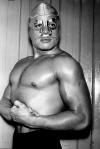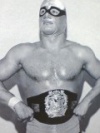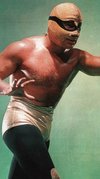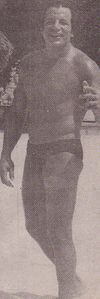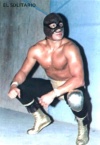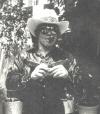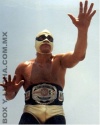El Solitario
Profile
| El Solitario (The Lone One) | |||||||||||||||||||||||||||||
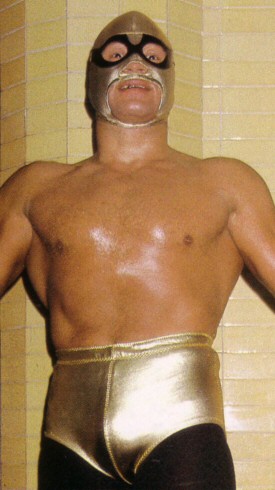 |
|
||||||||||||||||||||||||||||
| Wrestling Observer Hall Of Fame Member |
|---|
Biography
The tale of El Solitario is a very special one. He debuted at age 14, was a main eventer at age 24 and died at age 39, but he was such a great worker and drawing card and influenced so many wrestlers that nobody that knew him or knows about him would ever deny that he is a legend... a huge legend, accompanied by Ray Mendoza, Mil Mascaras and others in the second step of a ladder whose unreachable higher step is occupied by Santo and Blue Demon.
Roberto González Cruz was born on May 22, 1946 in a little town of Jalisco called Yahualica. He was the youngest of a 7 children family that didn't live in the best of economical conditions, or anything remotely close to that.
As a kid he was a "rebel" not into the school studying at all, and also an unconformist because he didn't want to stay in that little town forever, living in poverty and working way too hard to earn very little money. So at a very young age, he left his family to live life his own way... and ended up becoming a wrestler.
His family already had a wrestling background, as Roberto's brother, Jesús wrestled as Othon Banzica during years at local arenas. In 1959, a very sad incident happened and Othon Banzica died in the ring. Roberto really idolized and looked up to his older brother, and his tragic death caused a rage and revenge feeling on young Roberto that pushed him to step into the ring to somehow, in his mind, avenge his brother's death by succeeding and becoming a top star.
He started training under local wrestler Joe El Hermoso's tutelage at the "Gallo Madrugador" gym, which didn't sit well with his parents because of what happened to Jesús. However Roberto was in a mission and wasn't going to give up, and after several months, in the year of 1960, at age 14 or 15, he made his debut in his home state, along with another young kid called Adolfo Contreras that years later would be known as "El Hippie" Renato Torres (who was a famous independent star of the 70s and a good real life friend of Roberto).
The first promoter he (and Contreras) wrestled for was Elías Simón, wrestling from Saturday to Monday in Ciudad Guzmán, Jalisco and Tecomán and Manzanillo, both in Colima state. Simón's "brilliant" idea to make these guys sell tickets was announcing them as juniors of big stars. They wrestled unmasked, and while Roberto was always billed as El Hijo del Santo, Adolfo was the son of Charro Aguayo or Blue Demon.
But Roberto decided that the best thing was to become his own self and continued the family name becoming Othon Banzica II, though this name would eventually get shortened as "El Zica II", and later the number was dropped.
He moved to Tijuana but local big time promoter Black Nassel didn't want to use him because he was too young and skinny. As a rookie, Roberto was a good athlete and very tough for a guy his age, but he didn't have any muscular definition. That, however, changed with time as he was a hard gym worker that took care of his body.
In Tijuana he didn't have any money or friends or family, so he lived in an abandoned car. Trying to find work he saw that the city was plagued with night clubs and got a job in a club where he had to darken his body with burnt motor oil to look African and play the bongos while an exotic dancer did her job. But the pay wasn't right either, so Roberto swallowed his pride and apologized to his parents, asking them for money to return back home.
But he didn't quit wrestling there, in fact he trained harder than ever and he made a name for himself in the local arenas and his work paid back as he got a call from big local promoters Julián Sánchez and Ray Plata from Arena Coliseo in Guadalajara, Jalisco.
Ray Plata had a long time in the business and knew that El Sica needed a name and costume change if he wanted to succeed in Mexico City. His work was improving very well, as the once skinny and clueless kid with no sense of timing was now a good and polished worker. But still, that name he had, was not the one of a star.
The magic touch Roberto needed was getting named "El Solitario" (The Lonely One), a name based on the famous comic and TV series "El Llanero Solitario" (Lone Ranger). In fact he didn't call himself El Llanero Solitario to avoid copyright infringement problems. He then adopted his classic golden/black tights and his golden mask with a fringe around the eyes representing Lone Ranger's "antifaz" mask. Solitario was one of the first wrestlers to use a mask with a wide open mouth, which is a popular design now used by people like Atlantis, Octagon and Ultimo Guerrero among others.
This name change happened in 1966, and not coincidentally, that was his first big year in the business. In Guadalajara he unmasked Aguila Tapatía and The White Hand (La Mano Blanca), he won the Occident Welterweight Title from Luis González and if that wasn't enough, he also took his hair.
He started wrestling in Mexico City for EMLL by the end of that year (his debut there was on September 6) and was a rapidly growing young star but when he really made it big, was when he challenged legendary veteran Ray Mendoza to a hair vs. mask match that was due to happen on December 13, 1968... and WON! And if that wasn't enough, two weeks later he also took the hair of another legend, René Guajardo! Soli, still a rudo, was the hottest thing on lucha libre at the moment and his drawing power skyrocketed just like his workrate did, as by this point he was considered by many the best wrestler in all of Mexico.
Around that time he started what would later become a legendary trio with El Ángel Blanco and Dr. Wagner, while attaining success in singles competition too, as on August 15, 1969 he defeated El Rayo de Jalisco to win the NWA World Middleweight title.
Solitario was such a popular rudo that when Ángel Blanco and Dr. Wagner turned on him, he became a tecnico as popular as anyone in that era, including Santo, Rayo de Jalisco and Blue Demon. And of course, this also gave start to his legendary feud against "Ola Blanca" members Blanco and Wagner, with him finally taking both white masked men's masks (Ángel's didn't take so long, but for the match vs. Wagner we almost had to wait 15 years). And all of this while piling up more titles like the NWA World Light Heavyweight title (a title that during many years was considered the biggest prize in all of Mexico) he won from Ray Mendoza and lost to David Morgan (who eventually got his payback via a Kojak style haircut courtesy of El Soli).
Roberto was also one of the first wrestlers to leave EMLL in December of 1975 to join the independent wrestling revolution commanded by Ray Mendoza and promoter Francisco Flores. During his first "indie" years, Solitario continued his now legendary feuds against La Ola Blanca and Ray Mendoza, and also started new rivalries against new talent like Atila and Audaz.
But his fame wasn't only limited to Mexico. He also was a hot ticket in Los Angeles' Olympic Auditorium and generated a cult fan base in Japan with his tours for New Japan Pro Wrestling. He only went to Japan three times but he was actually more popular that you'd think, the only problem is that at first he was often paired up against superheavyweights like Giant Baba and Seiji Sakaguchi who couldn't work his style, so he could not go out there and impress, and when junior heavyweight wrestling became hot in Japan it was already a bit late, and either way, then the junior division's formula consisted of Tiger Mask against foreign heels, so Soli couldn't have been in line for a big push.
His first tour to Japan was in 1972, the second one in 1979 and the last one in 1981. In the second tour there was a Chavo Guerrero & Tatsumi Fujinami vs. El Canek & Solitario match that went around 45 minutes and is today referred to by Japanese historians as a "juniors dream match", and in his final tour, Tigermania was runnin' wild and he got the chance to both face and team with the original Tiger Mask.
While in Mexico, he was one of the biggest headlining stars not only at El Toreo and Arena Mexico, but in the whole country. During a time in the middle of the "trios golden years" in the early 80s, he formed a short lived dream team with Villano III and Aníbal called "Los Tres Caballeros" (The Three Knights), though Soli always was, like his name says, a lone ranger. He captured several more titles and headlined virtually everywhere he went. In some places he gained himself a reputation among promoters as a tough guy to work with, but his drawing power and in-ring work ethic made him a horse you could bet for with no risk of losing.
But the most legendary feud of Roberto ended up being his long time rivalry with Wagner, to the point it overshadows his also legendary feuds against Blanco, Mendoza and Perro Aguayo. The legendary "war to settle it all", the mask vs. mask match against Wagner, happened on December 1, 1985 at the enormous Plaza de Toros (Bullring) Monumental in Monterrey, Nuevo León where their popularity (especially Wagner's) was even bigger than in Mexico City. It was a dramatic slower paced match with a lot of submissions and some parts where the match would sped up and Soli could use his big moves. A clipped version of it exists on video and it's a true classic.
Solitario's life finished in a very sad way on April 6, 1986. As the "official" story goes, Solitario had a very serious injury that wasn't taken care of properly (some say knee, some say back) so during a match with Fishman, he re-injured himself during a dangerous maneuver and needed urgent surgery (I don't know if this part is true) and while he was in the operation table, his damaged body couldn't take the anesthetic so he had a heart attack and died. Sometimes there is contradictions, though we all bought this story and even many historians don't know what really happened. In fact many of Solitario's close wrestling friends don't even know what happened, like Canek and Blue Demon have stated in the past. There also was a history going around in Mexico City (that I heard from a former WCW star) that says that Solitario was high on cocaine and didn't tell the doctors, so the combo of it with anesthesia caused that heart attack. This one is an urban legend, too.
As Blue Demon said in his autobiography, Solitario died of a "very strange illness" that he never talked about when he was alive. People close to Solitario have confirmed this one, as he died from a virus, side-effect of his lifestyle. It was a very sad way to end for such a legendary man, but as the song goes, "only the good die young".
Five years later, a legitimate son of Solitario made his debut as "El Hijo del Solitario". He's a young guy with size and athleticism, but he has never had pride in his work, and even years after his debut he looks like he doesn't even know what to do in the ring. The kid always has "hanged out with the wrong crowds" too, which doesn't help matters.
But even with his son somewhat staining the golden legend, Solitario is fondly remembered by people both in and outside the business, and he is always a top five wrestler in everybody's top stars, top workers and most influential wrestlers in Mexico lists.
Luchas de apuestas record
Gallery
